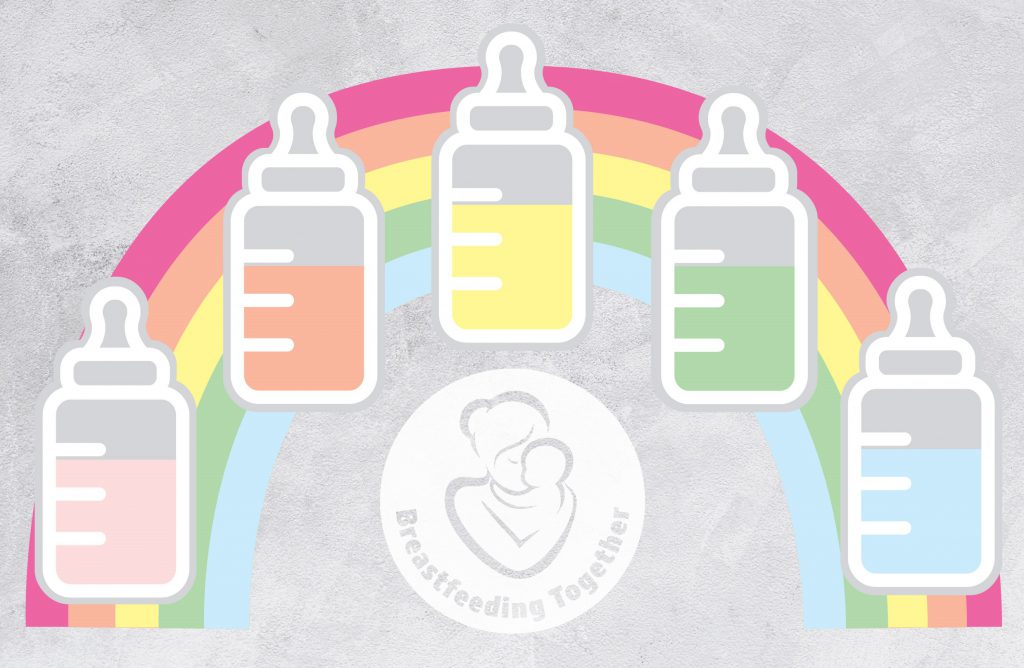
Breast milk. It’s white right? Or perhaps a bit more creamy or yellowy in those early days, but we do generally think about milk being within that vanilla colour scheme. It can be quite a surprise then, on expressing that that’s not always the case, and if it isn’t does that mean something’s wrong?
Nope!
Let’s file that beautiful colour variation under perfectly natural and pretty amazing. Human milk comes in a variety of colours, with a variety of causes which can even change from one feed to the next! –
Colostrum-
That early colostrum is often very yellow in colour (almost like custard!) due to it being so concentrated and rich in fats and antibodies.
Later on you might notice this if you pump at the end of a feed or when the breast is relatively ‘empty’ as what tends to come out then is richer in those lovely fats. If your older baby is unwell you might see it return to this more yellowy colour as your body responds to your baby providing them with a concentrated hit of antibodies.
Foods-
Your milk is very cleverly flavoured by the foods and drinks in your diet. Research shows this makes babies much more likely to be more responsive to solid foods when they are ready to be introduced, as they’ve already had a ‘taste’! This favouring can also come with a bit of colouring too!
Greenish milk has been linked to consuming green veg, so if you’ve had a heavy night on the spinach you may have what we affectionately refer to as ‘Kermit milk’!!
Some food dyes, fruit drinks, and gelatine desserts have been associated with milk that is pink or pinkish orange.
And while the jury is out on whether carrots can make you see in the dark, if your diet has a lot of them or other yellow-orange vegetables, particularly if you eat them mashed, there can be high levels of carotene in your milk, which can turn it a bit yellow or orange!
Blood-
Pink milk may indicate blood in your milk. Sounds pretty grim, but this often just comes from a bit of damage to the nipple or within the breast. Seeing blood in your milk is of course worrying, but it is not harmful to your baby as your blood and milk are made from the same stuff, so you can keep on feeding even when it looks quite alarming! We’d probably suggest a full feed observation to make sure things are working as well as possible for you and to help improve any damage.
Brown milk may be caused by (the delightfully named) Rusty Pipe Syndrome- As our breasts grow and stretch ready for and during those first few days of breastfeeding, extra blood flows into to our boobs and it sometimes leaks into our milk ducts which can make your milk look brown or rust-coloured (like water from a rusty pipe-hence the name!). It should clear after a few days as more milk flows through your breasts, and it’s again fine to keep on feeding.
*If you notice suspected blood in your babies spit up or vomit that you suspect may not be caused by any of the above, it’s worth having them checked over by your Midwife, GP or healthcare provider to rule out other causes.
Blue Milk-
Around 40% of the protein in your milk is made up of casein, which has a natural blueish hue so it’s not uncommon for milk to appear to look a little blue too! This is usually more obvious when milk volume is high, or more watery and the fat content lower. You might notice this when pumping from full breasts or when the weather is hot and your boobs naturally provide a more thirst-quenching drink!
So…..
Don’t be too worried if your milk has more colours than a paint chart- remember if we weren’t expressing we’d often never even know, so go ahead and let that rainbow milk flow!
